oil FORD SIERRA 1991 2.G Engine Electrical Systems User Guide
[x] Cancel search | Manufacturer: FORD, Model Year: 1991, Model line: SIERRA, Model: FORD SIERRA 1991 2.GPages: 24, PDF Size: 0.93 MB
Page 14 of 24
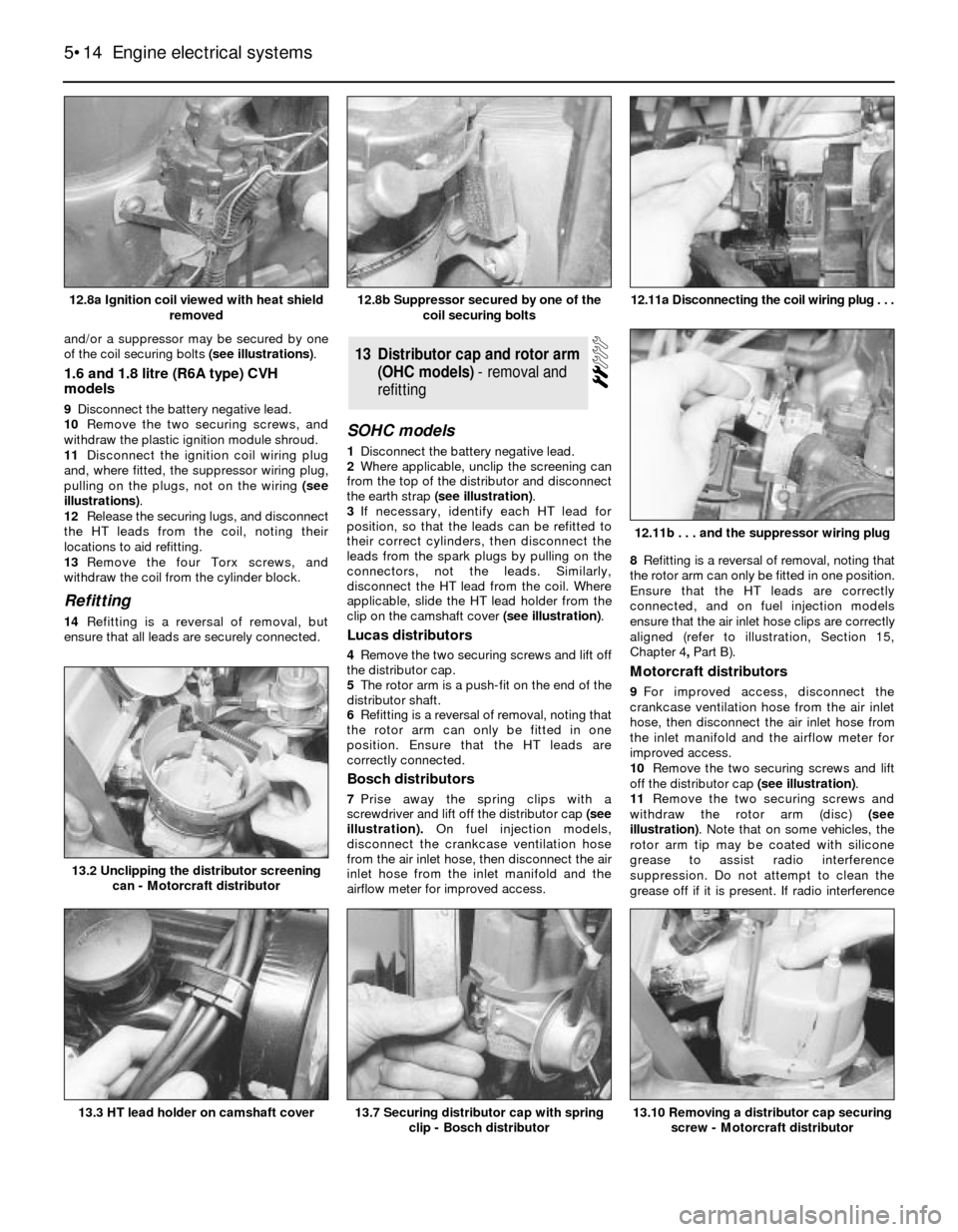
and/or a suppressor may be secured by one
of the coil securing bolts (see illustrations).
1.6 and 1.8 litre (R6A type) CVH
models
9Disconnect the battery negative lead.
10Remove the two securing screws, and
withdraw the plastic ignition module shroud.
11Disconnect the ignition coil wiring plug
and, where fitted, the suppressor wiring plug,
pulling on the plugs, not on the wiring (see
illustrations).
12Release the securing lugs, and disconnect
the HT leads from the coil, noting their
locations to aid refitting.
13Remove the four Torx screws, and
withdraw the coil from the cylinder block.
Refitting
14Refitting is a reversal of removal, but
ensure that all leads are securely connected.
SOHC models
1Disconnect the battery negative lead.
2Where applicable, unclip the screening can
from the top of the distributor and disconnect
the earth strap (see illustration).
3If necessary, identify each HT lead for
position, so that the leads can be refitted to
their correct cylinders, then disconnect the
leads from the spark plugs by pulling on the
connectors, not the leads. Similarly,
disconnect the HT lead from the coil. Where
applicable, slide the HT lead holder from the
clip on the camshaft cover (see illustration).
Lucas distributors
4Remove the two securing screws and lift off
the distributor cap.
5The rotor arm is a push-fit on the end of the
distributor shaft.
6Refitting is a reversal of removal, noting that
the rotor arm can only be fitted in one
position. Ensure that the HT leads are
correctly connected.
Bosch distributors
7Prise away the spring clips with a
screwdriver and lift off the distributor cap(see
illustration).On fuel injection models,
disconnect the crankcase ventilation hose
from the air inlet hose, then disconnect the air
inlet hose from the inlet manifold and the
airflow meter for improved access. 8Refitting is a reversal of removal, noting that
the rotor arm can only be fitted in one position.
Ensure that the HT leads are correctly
connected, and on fuel injection models
ensure that the air inlet hose clips are correctly
aligned (refer to illustration, Section 15,
Chapter 4, PartB).
Motorcraft distributors
9For improved access, disconnect the
crankcase ventilation hose from the air inlet
hose, then disconnect the air inlet hose from
the inlet manifold and the airflow meter for
improved access.
10Remove the two securing screws and lift
off the distributor cap (see illustration).
11Remove the two securing screws and
withdraw the rotor arm (disc) (see
illustration). Note that on some vehicles, the
rotor arm tip may be coated with silicone
grease to assist radio interference
suppression. Do not attempt to clean the
grease off if it is present. If radio interference
13Distributor cap and rotor arm
(OHC models) - removal and
refitting
5•14Engine electrical systems
12.8a Ignition coil viewed with heat shield
removed12.11a Disconnecting the coil wiring plug . . .
13.10 Removing a distributor cap securing
screw - Motorcraft distributor13.7 Securing distributor cap with spring
clip - Bosch distributor13.3 HT lead holder on camshaft cover
13.2 Unclipping the distributor screening
can - Motorcraft distributor
12.11b . . . and the suppressor wiring plug
12.8b Suppressor secured by one of the
coil securing bolts
Page 15 of 24
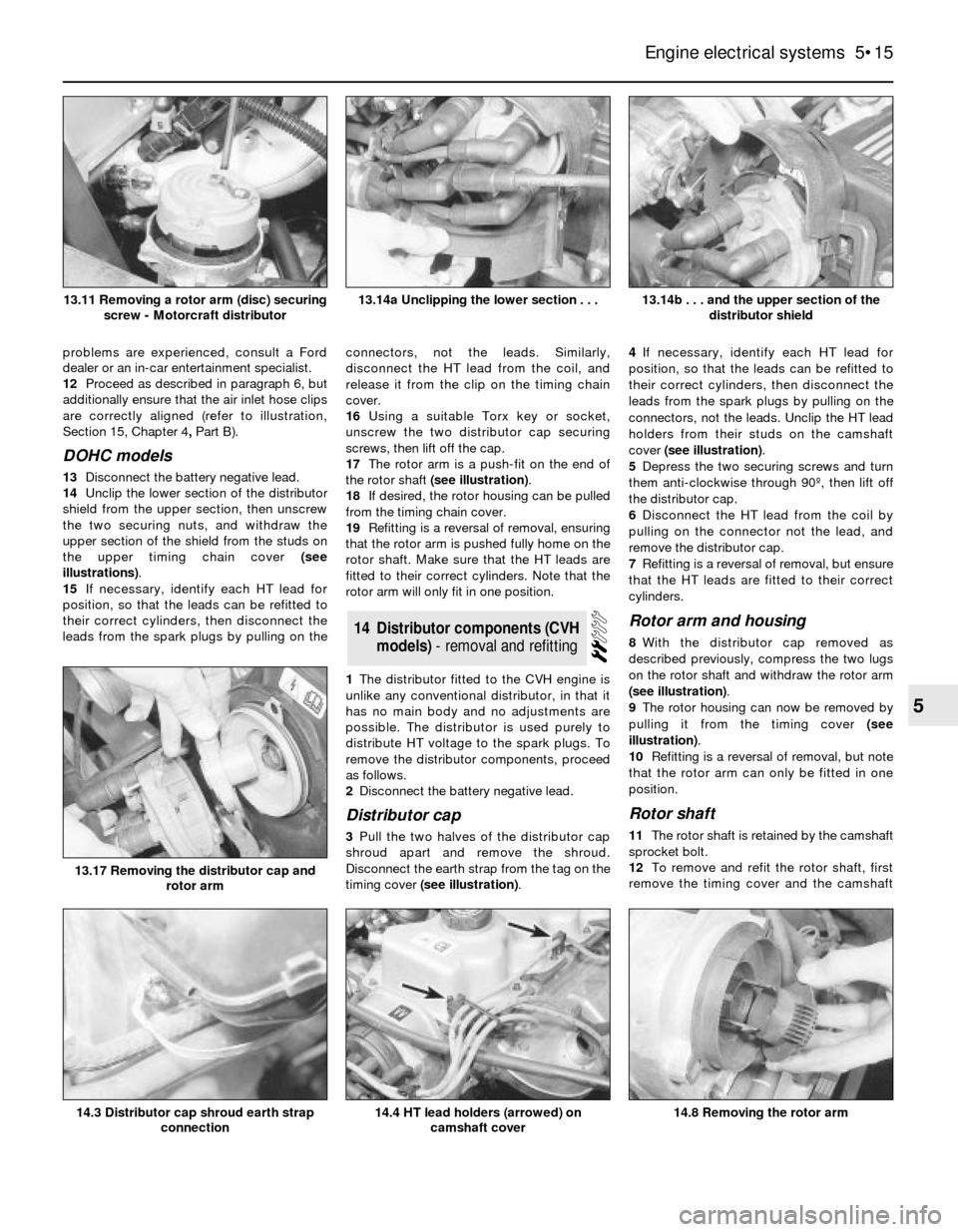
problems are experienced, consult a Ford
dealer or an in-car entertainment specialist.
12Proceed as described in paragraph 6, but
additionally ensure that the air inlet hose clips
are correctly aligned (refer to illustration,
Section 15, Chapter 4, PartB).
DOHC models
13Disconnect the battery negative lead.
14Unclip the lower section of the distributor
shield from the upper section, then unscrew
the two securing nuts, and withdraw the
upper section of the shield from the studs on
the upper timing chain cover (see
illustrations).
15If necessary, identify each HT lead for
position, so that the leads can be refitted to
their correct cylinders, then disconnect the
leads from the spark plugs by pulling on theconnectors, not the leads. Similarly,
disconnect the HT lead from the coil, and
release it from the clip on the timing chain
cover.
16Using a suitable Torx key or socket,
unscrew the two distributor cap securing
screws, then lift off the cap.
17The rotor arm is a push-fit on the end of
the rotor shaft (see illustration).
18If desired, the rotor housing can be pulled
from the timing chain cover.
19Refitting is a reversal of removal, ensuring
that the rotor arm is pushed fully home on the
rotor shaft. Make sure that the HT leads are
fitted to their correct cylinders. Note that the
rotor arm will only fit in one position.
1The distributor fitted to the CVH engine is
unlike any conventional distributor, in that it
has no main body and no adjustments are
possible. The distributor is used purely to
distribute HT voltage to the spark plugs. To
remove the distributor components, proceed
as follows.
2Disconnect the battery negative lead.
Distributor cap
3Pull the two halves of the distributor cap
shroud apart and remove the shroud.
Disconnect the earth strap from the tag on the
timing cover (see illustration).4If necessary, identify each HT lead for
position, so that the leads can be refitted to
their correct cylinders, then disconnect the
leads from the spark plugs by pulling on the
connectors, not the leads. Unclip the HT lead
holders from their studs on the camshaft
cover (see illustration).
5Depress the two securing screws and turn
them anti-clockwise through 90º, then lift off
the distributor cap.
6Disconnect the HT lead from the coil by
pulling on the connector not the lead, and
remove the distributor cap.
7Refitting is a reversal of removal, but ensure
that the HT leads are fitted to their correct
cylinders.
Rotor arm and housing
8With the distributor cap removed as
described previously, compress the two lugs
on the rotor shaft and withdraw the rotor arm
(see illustration).
9The rotor housing can now be removed by
pulling it from the timing cover (see
illustration).
10Refitting is a reversal of removal, but note
that the rotor arm can only be fitted in one
position.
Rotor shaft
11The rotor shaft is retained by the camshaft
sprocket bolt.
12To remove and refit the rotor shaft, first
remove the timing cover and the camshaft
14Distributor components (CVH
models) - removal and refitting
Engine electrical systems 5•15
5
13.14b . . . and the upper section of the
distributor shield
14.8 Removing the rotor arm14.4 HT lead holders (arrowed) on
camshaft cover14.3 Distributor cap shroud earth strap
connection
13.17 Removing the distributor cap and
rotor arm
13.14a Unclipping the lower section . . .13.11 Removing a rotor arm (disc) securing
screw - Motorcraft distributor
Page 16 of 24
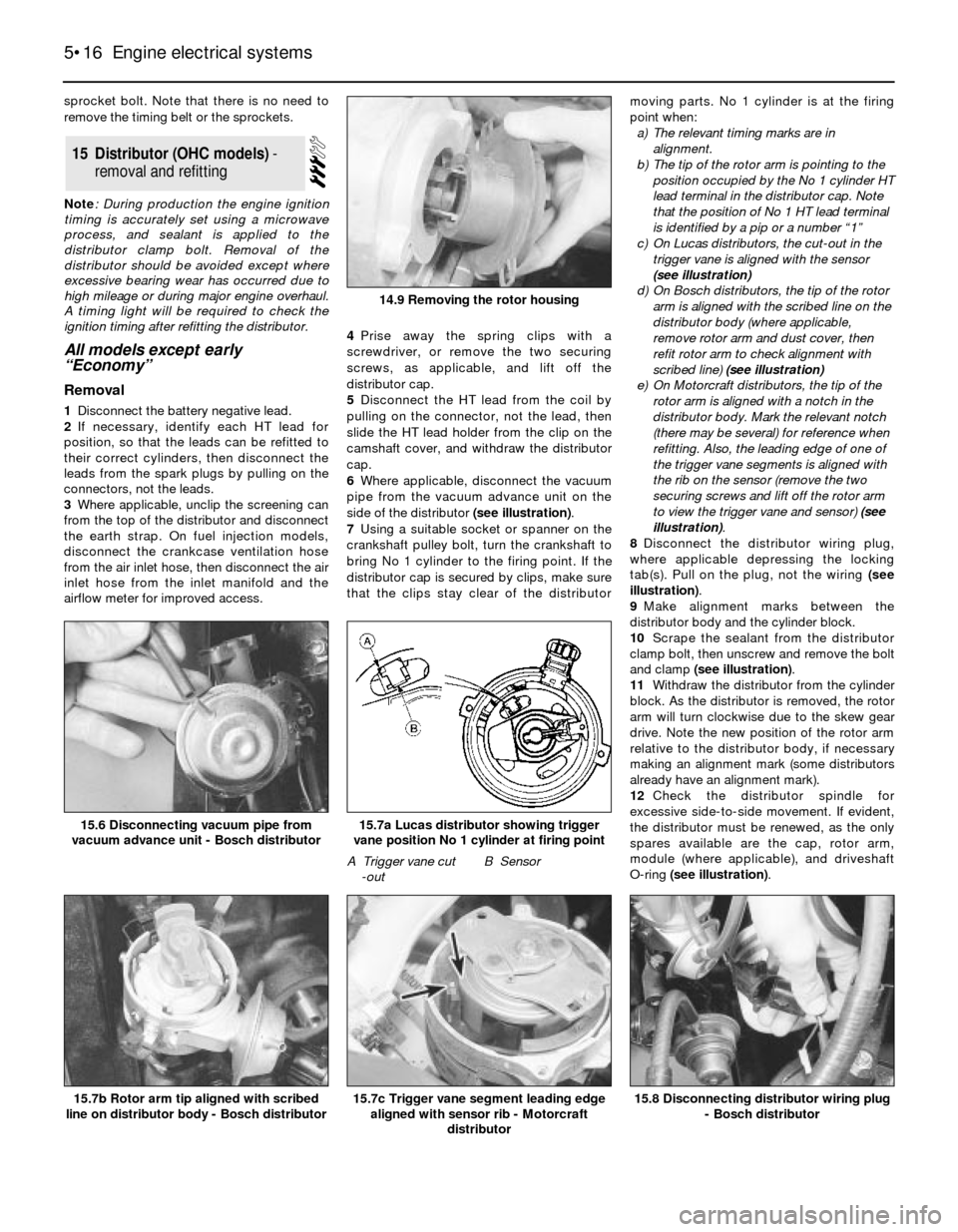
sprocket bolt. Note that there is no need to
remove the timing belt or the sprockets.
Note: During production the engine ignition
timing is accurately set using a microwave
process, and sealant is applied to the
distributor clamp bolt. Removal of the
distributor should be avoided except where
excessive bearing wear has occurred due to
high mileage or during major engine overhaul.
A timing light will be required to check the
ignition timing after refitting the distributor.
All models except early
“Economy”
Removal
1Disconnect the battery negative lead.
2If necessary, identify each HT lead for
position, so that the leads can be refitted to
their correct cylinders, then disconnect the
leads from the spark plugs by pulling on the
connectors, not the leads.
3Where applicable, unclip the screening can
from the top of the distributor and disconnect
the earth strap. On fuel injection models,
disconnect the crankcase ventilation hose
from the air inlet hose, then disconnect the air
inlet hose from the inlet manifold and the
airflow meter for improved access.4Prise away the spring clips with a
screwdriver, or remove the two securing
screws, as applicable, and lift off the
distributor cap.
5Disconnect the HT lead from the coil by
pulling on the connector, not the lead, then
slide the HT lead holder from the clip on the
camshaft cover, and withdraw the distributor
cap.
6Where applicable, disconnect the vacuum
pipe from the vacuum advance unit on the
side of the distributor (see illustration).
7Using a suitable socket or spanner on the
crankshaft pulley bolt, turn the crankshaft to
bring No 1 cylinder to the firing point. If the
distributor cap is secured by clips, make sure
that the clips stay clear of the distributormoving parts. No 1 cylinder is at the firing
point when:
a)The relevant timing marks are in
alignment.
b)The tip of the rotor arm is pointing to the
position occupied by the No 1 cylinder HT
lead terminal in the distributor cap. Note
that the position of No 1 HT lead terminal
is identified by a pip or a number “1”
c)On Lucas distributors, the cut-out in the
trigger vane is aligned with the sensor
(see illustration)
d)On Bosch distributors, the tip of the rotor
arm is aligned with the scribed line on the
distributor body (where applicable,
remove rotor arm and dust cover, then
refit rotor arm to check alignment with
scribed line) (see illustration)
e)On Motorcraft distributors, the tip of the
rotor arm is aligned with a notch in the
distributor body. Mark the relevant notch
(there may be several) for reference when
refitting. Also, the leading edge of one of
the trigger vane segments is aligned with
the rib on the sensor (remove the two
securing screws and lift off the rotor arm
to view the trigger vane and sensor) (see
illustration).
8Disconnect the distributor wiring plug,
where applicable depressing the locking
tab(s). Pull on the plug, not the wiring (see
illustration).
9Make alignment marks between the
distributor body and the cylinder block.
10Scrape the sealant from the distributor
clamp bolt, then unscrew and remove the bolt
and clamp (see illustration).
11Withdraw the distributor from the cylinder
block. As the distributor is removed, the rotor
arm will turn clockwise due to the skew gear
drive. Note the new position of the rotor arm
relative to the distributor body, if necessary
making an alignment mark (some distributors
already have an alignment mark).
12Check the distributor spindle for
excessive side-to-side movement. If evident,
the distributor must be renewed, as the only
spares available are the cap, rotor arm,
module (where applicable), and driveshaft
O-ring (see illustration).
15Distributor (OHC models) -
removal and refitting
5•16Engine electrical systems
14.9 Removing the rotor housing
15.7a Lucas distributor showing trigger
vane position No 1 cylinder at firing point
A Trigger vane cut
-outB Sensor
15.8 Disconnecting distributor wiring plug
- Bosch distributor15.7c Trigger vane segment leading edge
aligned with sensor rib - Motorcraft
distributor15.7b Rotor arm tip aligned with scribed
line on distributor body - Bosch distributor
15.6 Disconnecting vacuum pipe from
vacuum advance unit - Bosch distributor
Page 17 of 24
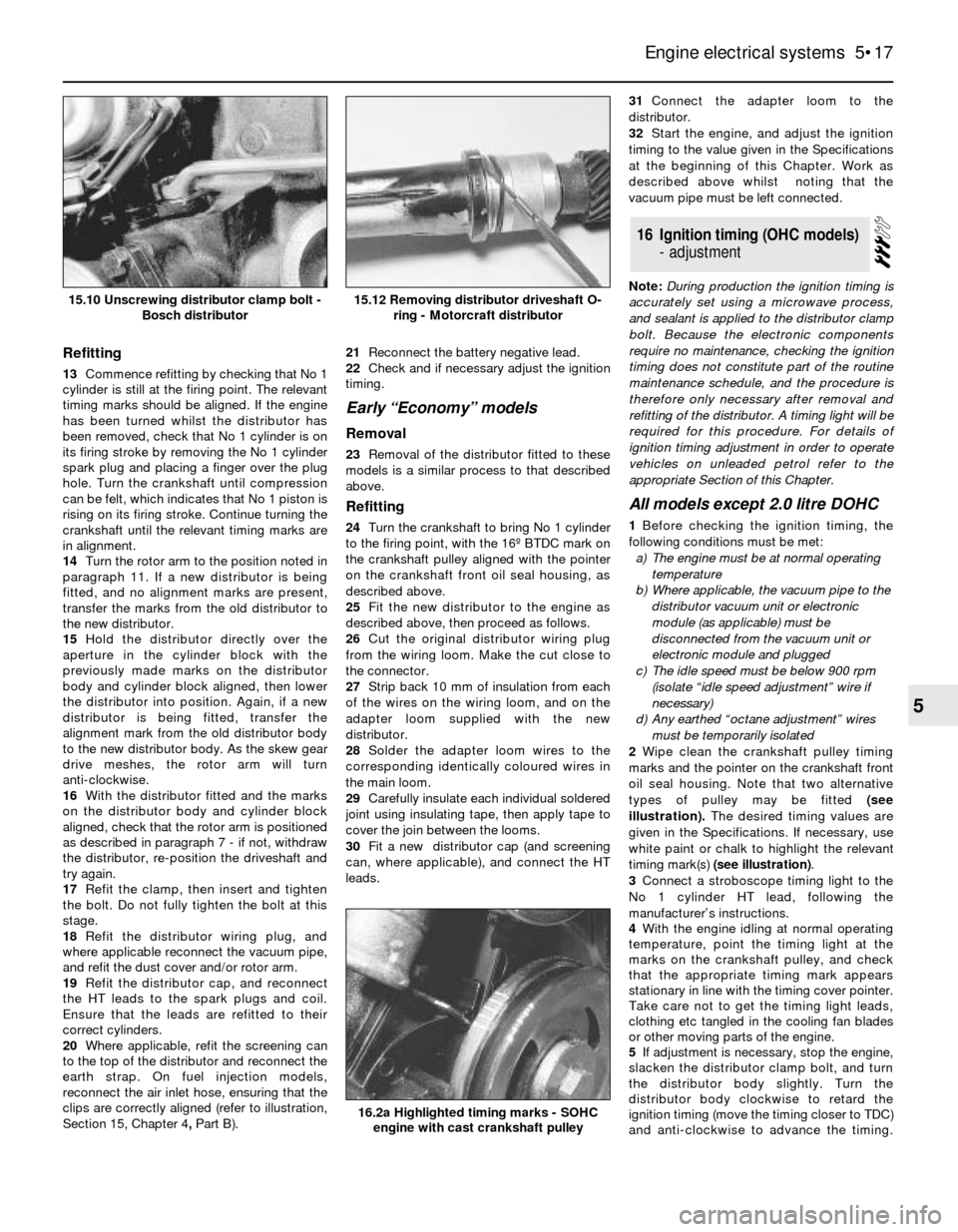
Refitting
13Commence refitting by checking that No 1
cylinder is still at the firing point. The relevant
timing marks should be aligned. If the engine
has been turned whilst the distributor has
been removed, check that No 1 cylinder is on
its firing stroke by removing the No 1 cylinder
spark plug and placing a finger over the plug
hole. Turn the crankshaft until compression
can be felt, which indicates that No 1 piston is
rising on its firing stroke. Continue turning the
crankshaft until the relevant timing marks are
in alignment.
14Turn the rotor arm to the position noted in
paragraph 11. If a new distributor is being
fitted, and no alignment marks are present,
transfer the marks from the old distributor to
the new distributor.
15Hold the distributor directly over the
aperture in the cylinder block with the
previously made marks on the distributor
body and cylinder block aligned, then lower
the distributor into position. Again, if a new
distributor is being fitted, transfer the
alignment mark from the old distributor body
to the new distributor body. As the skew gear
drive meshes, the rotor arm will turn
anti-clockwise.
16With the distributor fitted and the marks
on the distributor body and cylinder block
aligned, check that the rotor arm is positioned
as described in paragraph 7 -if not, withdraw
the distributor, re-position the driveshaft and
try again.
17Refit the clamp, then insert and tighten
the bolt. Do not fully tighten the bolt at this
stage.
18Refit the distributor wiring plug, and
where applicable reconnect the vacuum pipe,
and refit the dust cover and/or rotor arm.
19Refit the distributor cap, and reconnect
the HT leads to the spark plugs and coil.
Ensure that the leads are refitted to their
correct cylinders.
20Where applicable, refit the screening can
to the top of the distributor and reconnect the
earth strap. On fuel injection models,
reconnect the air inlet hose, ensuring that the
clips are correctly aligned (refer to illustration,
Section 15, Chapter 4, PartB).21Reconnect the battery negative lead.
22Check and if necessary adjust the ignition
timing.
Early “Economy” models
Removal
23Removal of the distributor fitted to these
models is a similar process to that described
above.
Refitting
24Turn the crankshaft to bring No 1 cylinder
to the firing point, with the 16º BTDC mark on
the crankshaft pulley aligned with the pointer
on the crankshaft front oil seal housing, as
described above.
25Fit the new distributor to the engine as
described above, then proceed as follows.
26Cut the original distributor wiring plug
from the wiring loom. Make the cut close to
the connector.
27Strip back 10 mm of insulation from each
of the wires on the wiring loom, and on the
adapter loom supplied with the new
distributor.
28Solder the adapter loom wires to the
corresponding identically coloured wires in
the main loom.
29Carefully insulate each individual soldered
joint using insulating tape, then apply tape to
cover the join between the looms.
30Fit a new distributor cap (and screening
can, where applicable), and connect the HT
leads.31Connect the adapter loom to the
distributor.
32Start the engine, and adjust the ignition
timing to the value given in the Specifications
at the beginning of this Chapter. Work as
described above whilst noting that the
vacuum pipe must be left connected.
Note: During production the ignition timing is
accurately set using a microwave process,
and sealant is applied to the distributor clamp
bolt. Because the electronic components
require no maintenance, checking the ignition
timing does not constitute part of the routine
maintenance schedule, and the procedure is
therefore only necessary after removal and
refitting of the distributor. A timing light will be
required for this procedure. For details of
ignition timing adjustment in order to operate
vehicles on unleaded petrol refer to the
appropriate Section of this Chapter.
All models except 2.0 litre DOHC
1Before checking the ignition timing, the
following conditions must be met:
a)The engine must be at normal operating
temperature
b)Where applicable, the vacuum pipe to the
distributor vacuum unit or electronic
module (as applicable) must be
disconnected from the vacuum unit or
electronic module and plugged
c)The idle speed must be below 900 rpm
(isolate “idle speed adjustment” wire if
necessary)
d)Any earthed “octane adjustment” wires
must be temporarily isolated
2Wipe clean the crankshaft pulley timing
marks and the pointer on the crankshaft front
oil seal housing. Note that two alternative
types of pulley may be fitted (see
illustration).The desired timing values are
given in the Specifications. If necessary, use
white paint or chalk to highlight the relevant
timing mark(s) (see illustration).
3Connect a stroboscope timing light to the
No 1 cylinder HT lead, following the
manufacturer’s instructions.
4With the engine idling at normal operating
temperature, point the timing light at the
marks on the crankshaft pulley, and check
that the appropriate timing mark appears
stationary in line with the timing cover pointer.
Take care not to get the timing light leads,
clothing etc tangled in the cooling fan blades
or other moving parts of the engine.
5If adjustment is necessary, stop the engine,
slacken the distributor clamp bolt, and turn
the distributor body slightly. Turn the
distributor body clockwise to retard the
ignition timing (move the timing closer to TDC)
and anti-clockwise to advance the timing.
16Ignition timing (OHC models)
- adjustment
Engine electrical systems 5•17
5
15.12 Removing distributor driveshaft O-
ring - Motorcraft distributor15.10 Unscrewing distributor clamp bolt -
Bosch distributor
16.2a Highlighted timing marks - SOHC
engine with cast crankshaft pulley
Page 18 of 24
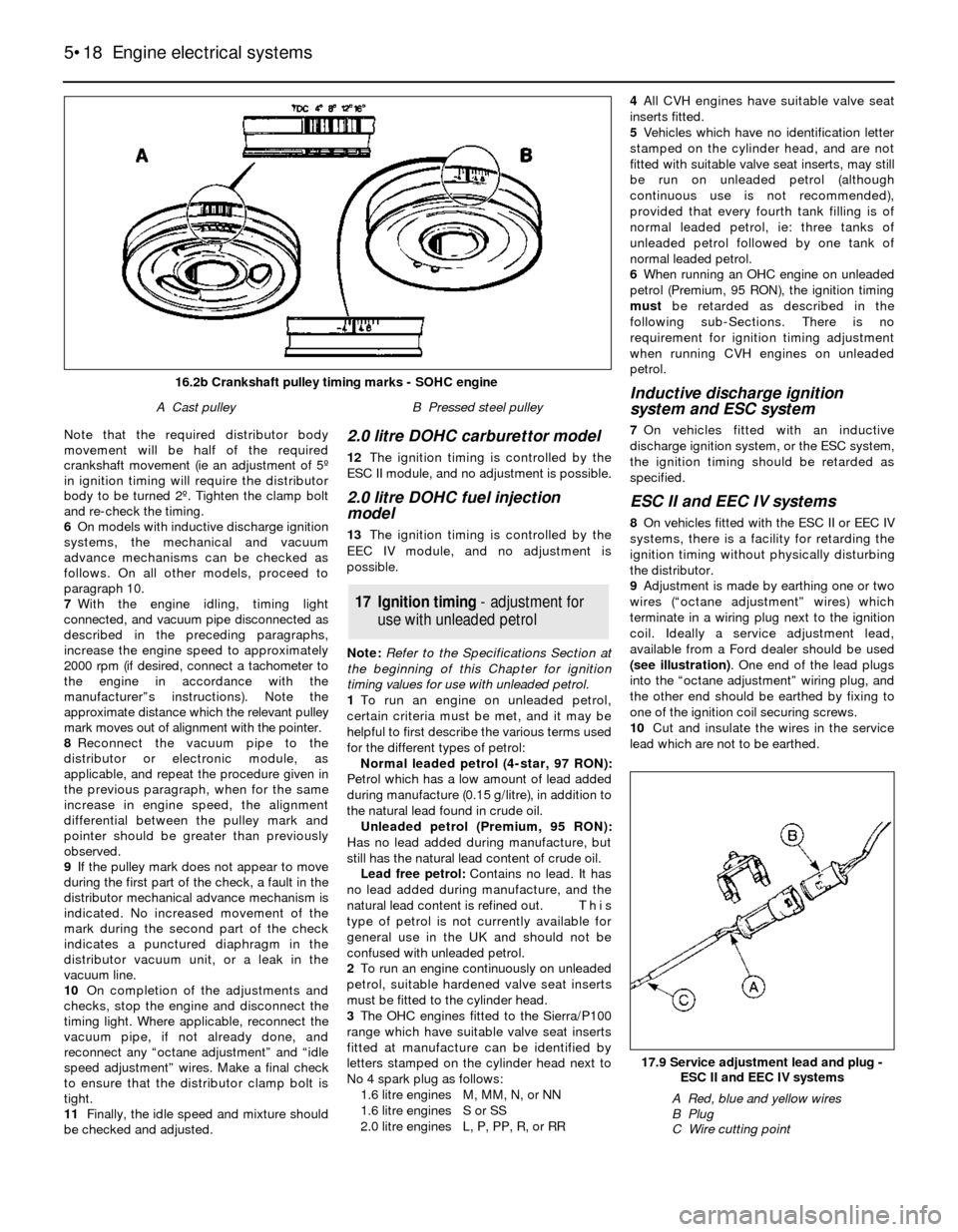
Note that the required distributor body
movement will be half of the required
crankshaft movement (ie an adjustment of 5º
in ignition timing will require the distributor
body to be turned 2º. Tighten the clamp bolt
and re-check the timing.
6On models with inductive discharge ignition
systems, the mechanical and vacuum
advance mechanisms can be checked as
follows. On all other models, proceed to
paragraph 10.
7With the engine idling, timing light
connected, and vacuum pipe disconnected as
described in the preceding paragraphs,
increase the engine speed to approximately
2000 rpm (if desired, connect a tachometer to
the engine in accordance with the
manufacturer”s instructions). Note the
approximate distance which the relevant pulley
mark moves out of alignment with the pointer.
8Reconnect the vacuum pipe to the
distributor or electronic module, as
applicable, and repeat the procedure given in
the previous paragraph, when for the same
increase in engine speed, the alignment
differential between the pulley mark and
pointer should be greater than previously
observed.
9If the pulley mark does not appear to move
during the first part of the check, a fault in the
distributor mechanical advance mechanism is
indicated. No increased movement of the
mark during the second part of the check
indicates a punctured diaphragm in the
distributor vacuum unit, or a leak in the
vacuum line.
10On completion of the adjustments and
checks, stop the engine and disconnect the
timing light. Where applicable, reconnect the
vacuum pipe, if not already done, and
reconnect any “octane adjustment” and “idle
speed adjustment” wires. Make a final check
to ensure that the distributor clamp bolt is
tight.
11Finally, the idle speed and mixture should
be checked and adjusted.2.0 litre DOHC carburettor model
12The ignition timing is controlled by the
ESC II module, and no adjustment is possible.
2.0 litre DOHC fuel injection
model
13The ignition timing is controlled by the
EEC IV module, and no adjustment is
possible.
Note: Refer to the Specifications Section at
the beginning of this Chapter for ignition
timing values for use with unleaded petrol.
1To run an engine on unleaded petrol,
certain criteria must be met, and it may be
helpful to first describe the various terms used
for the different types of petrol:
Normal leaded petrol (4-star, 97 RON):
Petrol which has a low amount of lead added
during manufacture (0.15 g/litre), in addition to
the natural lead found in crude oil.
Unleaded petrol (Premium, 95 RON):
Has no lead added during manufacture, but
still has the natural lead content of crude oil.
Lead free petrol: Contains no lead. It has
no lead added during manufacture, and the
natural lead content is refined out. This
type of petrol is not currently available for
general use in the UK and should not be
confused with unleaded petrol.
2To run an engine continuously on unleaded
petrol, suitable hardened valve seat inserts
must be fitted to the cylinder head.
3The OHC engines fitted to the Sierra/P100
range which have suitable valve seat inserts
fitted at manufacture can be identified by
letters stamped on the cylinder head next to
No 4 spark plug as follows:
1.6 litre enginesM, MM, N, or NN
1.6 litre enginesS or SS
2.0 litre enginesL, P, PP, R, or RR4All CVH engines have suitable valve seat
inserts fitted.
5Vehicles which have no identification letter
stamped on the cylinder head, and are not
fitted with suitable valve seat inserts, may still
be run on unleaded petrol (although
continuous use is not recommended),
provided that every fourth tank filling is of
normal leaded petrol, ie: three tanks of
unleaded petrol followed by one tank of
normal leaded petrol.
6When running an OHC engine on unleaded
petrol (Premium, 95 RON), the ignition timing
must be retarded as described in the
following sub-Sections. There is no
requirement for ignition timing adjustment
when running CVH engines on unleaded
petrol.
Inductive discharge ignition
system and ESC system
7On vehicles fitted with an inductive
discharge ignition system, or the ESC system,
the ignition timing should be retarded as
specified.
ESC II and EEC IV systems
8On vehicles fitted with the ESC II or EEC IV
systems, there is a facility for retarding the
ignition timing without physically disturbing
the distributor.
9Adjustment is made by earthing one or two
wires (“octane adjustment” wires) which
terminate in a wiring plug next to the ignition
coil. Ideally a service adjustment lead,
available from a Ford dealer should be used
(see illustration). One end of the lead plugs
into the “octane adjustment” wiring plug, and
the other end should be earthed by fixing to
one of the ignition coil securing screws.
10Cut and insulate the wires in the service
lead which are not to be earthed.
17Ignition timing -adjustmentfor
usewithunleadedpetrol
5•18Engine electrical systems
17.9 Service adjustment lead and plug -
ESC II and EEC IV systems
A Red, blue and yellow wires
B Plug
C Wire cutting point
16.2b Crankshaft pulley timing marks - SOHC engine
A Cast pulleyB Pressed steel pulley
Page 19 of 24
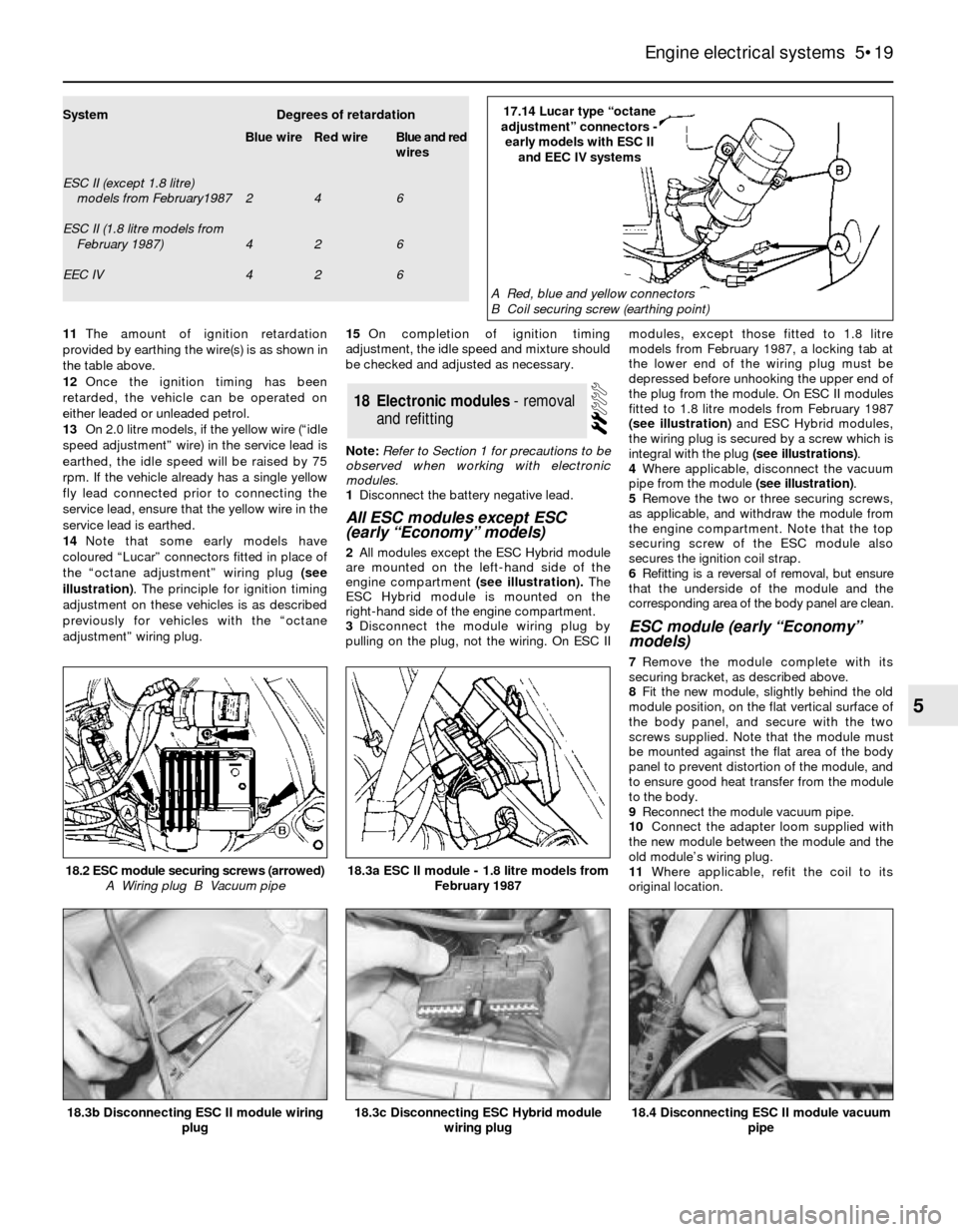
11The amount of ignition retardation
provided by earthing the wire(s) is as shown in
the table above.
12Once the ignition timing has been
retarded, the vehicle can be operated on
either leaded or unleaded petrol.
13On 2.0 litre models, if the yellow wire (“idle
speed adjustment” wire) in the service lead is
earthed, the idle speed will be raised by 75
rpm. If the vehicle already has a single yellow
fly lead connected prior to connecting the
service lead, ensure that the yellow wire in the
service lead is earthed.
14Note that some early models have
coloured “Lucar” connectors fitted in place of
the “octane adjustment” wiring plug (see
illustration). The principle for ignition timing
adjustment on these vehicles is as described
previously for vehicles with the “octane
adjustment” wiring plug.15On completion of ignition timing
adjustment, the idle speed and mixture should
be checked and adjusted as necessary.
Note: Refer to Section 1 for precautions to be
observed when working with electronic
modules.
1Disconnect the battery negative lead.
All ESC modules except ESC
(early “Economy” models)
2All modules except the ESC Hybrid module
are mounted on the left-hand side of the
engine compartment(see illustration).The
ESC Hybrid module is mounted on the
right-hand side of the engine compartment.
3Disconnect the module wiring plug by
pulling on the plug, not the wiring. On ESC IImodules, except those fitted to 1.8 litre
models from February 1987, a locking tab at
the lower end of the wiring plug must be
depressed before unhooking the upper end of
the plug from the module. On ESC II modules
fitted to 1.8 litre models from February 1987
(see illustration)and ESC Hybrid modules,
the wiring plug is secured by a screw which is
integral with the plug (see illustrations).
4Where applicable, disconnect the vacuum
pipe from the module (see illustration).
5Remove the two or three securing screws,
as applicable, and withdraw the module from
the engine compartment. Note that the top
securing screw of the ESC module also
secures the ignition coil strap.
6Refitting is a reversal of removal, but ensure
that the underside of the module and the
corresponding area of the body panel are clean.
ESC module (early “Economy”
models)
7Remove the module complete with its
securing bracket, as described above.
8Fit the new module, slightly behind the old
module position, on the flat vertical surface of
the body panel, and secure with the two
screws supplied. Note that the module must
be mounted against the flat area of the body
panel to prevent distortion of the module, and
to ensure good heat transfer from the module
to the body.
9Reconnect the module vacuum pipe.
10Connect the adapter loom supplied with
the new module between the module and the
old module’s wiring plug.
11Where applicable, refit the coil to its
original location.
18Electronic modules - removal
and refitting
Engine electrical systems 5•19
5
18.4 Disconnecting ESC II module vacuum
pipe18.3c Disconnecting ESC Hybrid module
wiring plug18.3b Disconnecting ESC II module wiring
plug
18.2 ESC module securing screws (arrowed)
A Wiring plug B Vacuum pipe18.3a ESC II module - 1.8 litre models from
February 1987
SystemDegrees of retardation
Blue wireRed wireBlue and red
wires
ESC II (except 1.8 litre)
models from February1987246
ESC II (1.8 litre models from
February 1987)426
EEC IV42617.14 Lucar type “octane
adjustment” connectors -
early models with ESC II
and EEC IV systems
A Red, blue and yellow connectors
B Coil securing screw (earthing point)
Page 20 of 24
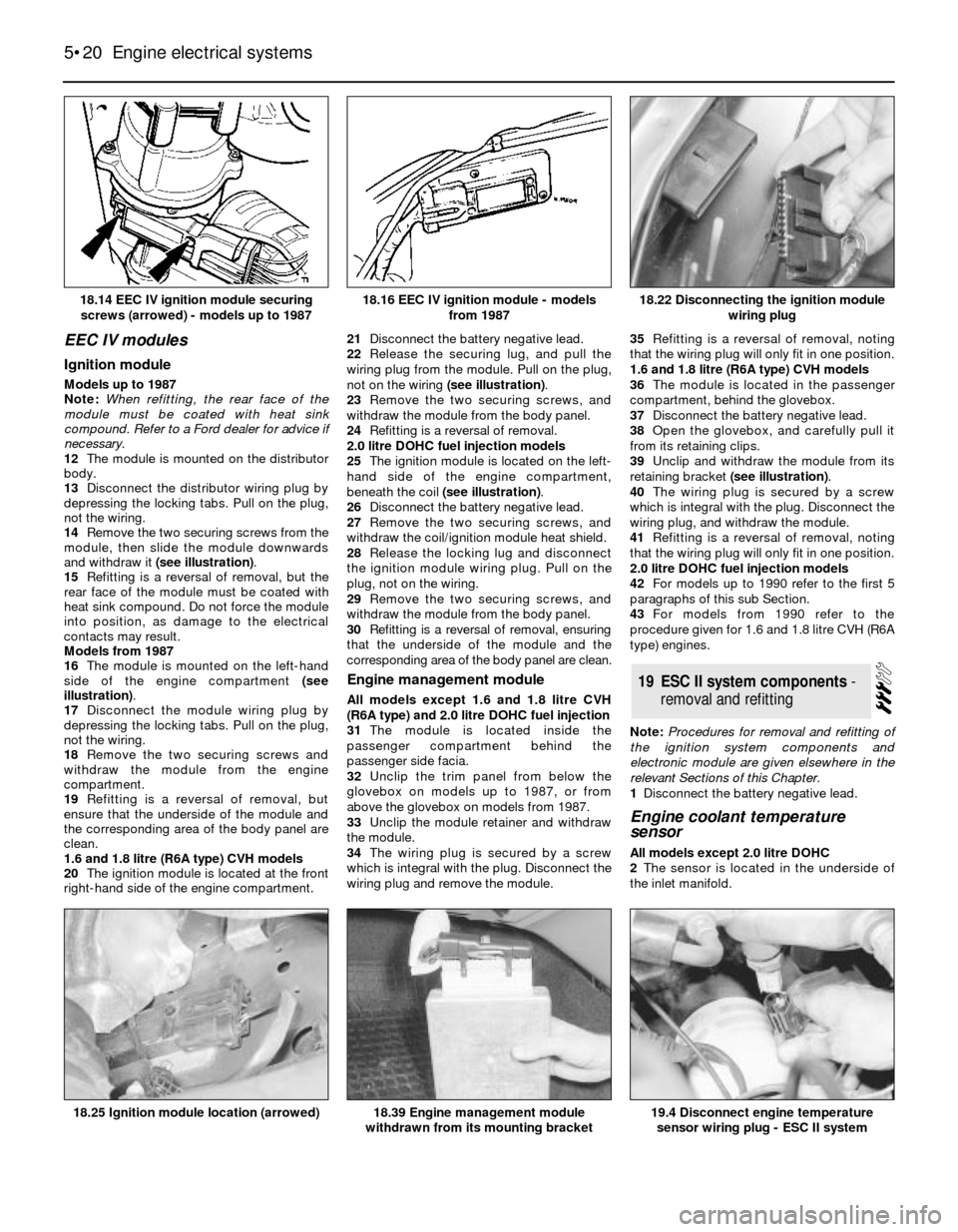
EEC IV modules
Ignition module
Models up to 1987
Note: When refitting, the rear face of the
module must be coated with heat sink
compound. Refer to a Ford dealer for advice if
necessary.
12The module is mounted on the distributor
body.
13Disconnect the distributor wiring plug by
depressing the locking tabs. Pull on the plug,
not the wiring.
14Remove the two securing screws from the
module, then slide the module downwards
and withdraw it (see illustration).
15Refitting is a reversal of removal, but the
rear face of the module must be coated with
heat sink compound. Do not force the module
into position, as damage to the electrical
contacts may result.
Models from 1987
16The module is mounted on the left-hand
side of the engine compartment (see
illustration).
17Disconnect the module wiring plug by
depressing the locking tabs. Pull on the plug,
not the wiring.
18Remove the two securing screws and
withdraw the module from the engine
compartment.
19Refitting is a reversal of removal, but
ensure that the underside of the module and
the corresponding area of the body panel are
clean.
1.6 and 1.8 litre (R6A type) CVH models
20The ignition module is located at the front
right-hand side of the engine compartment. 21Disconnect the battery negative lead.
22Release the securing lug, and pull the
wiring plug from the module. Pull on the plug,
not on the wiring (see illustration).
23Remove the two securing screws, and
withdraw the module from the body panel.
24Refitting is a reversal of removal.
2.0 litre DOHC fuel injection models
25The ignition module is located on the left-
hand side of the engine compartment,
beneath the coil (see illustration).
26Disconnect the battery negative lead.
27Remove the two securing screws, and
withdraw the coil/ignition module heat shield.
28Release the locking lug and disconnect
the ignition module wiring plug. Pull on the
plug, not on the wiring.
29Remove the two securing screws, and
withdraw the module from the body panel.
30Refitting is a reversal of removal, ensuring
that the underside of the module and the
corresponding area of the body panel are clean.
Engine management module
All models except 1.6 and 1.8 litre CVH
(R6A type) and 2.0 litre DOHC fuel injection
31The module is located inside the
passenger compartment behind the
passenger side facia.
32Unclip the trim panel from below the
glovebox on models up to 1987, or from
above the glovebox on models from 1987.
33Unclip the module retainer and withdraw
the module.
34The wiring plug is secured by a screw
which is integral with the plug. Disconnect the
wiring plug and remove the module.35Refitting is a reversal of removal, noting
that the wiring plug will only fit in one position.
1.6 and 1.8 litre (R6A type) CVH models
36The module is located in the passenger
compartment, behind the glovebox.
37Disconnect the battery negative lead.
38Open the glovebox, and carefully pull it
from its retaining clips.
39Unclip and withdraw the module from its
retaining bracket (see illustration).
40The wiring plug is secured by a screw
which is integral with the plug. Disconnect the
wiring plug, and withdraw the module.
41Refitting is a reversal of removal, noting
that the wiring plug will only fit in one position.
2.0 litre DOHC fuel injection models
42For models up to 1990 refer to the first 5
paragraphs of this sub Section.
43For models from 1990 refer to the
procedure given for 1.6 and 1.8 litre CVH (R6A
type) engines.
Note: Procedures for removal and refitting of
the ignition system components and
electronic module are given elsewhere in the
relevant Sections of this Chapter.
1Disconnect the battery negative lead.
Engine coolant temperature
sensor
All models except 2.0 litre DOHC
2The sensor is located in the underside of
the inlet manifold.
19ESC II system components -
removal and refitting
5•20Engine electrical systems
18.14 EEC IV ignition module securing
screws (arrowed) - models up to 198718.22 Disconnecting the ignition module
wiring plug
19.4 Disconnect engine temperature
sensor wiring plug - ESC II system18.39 Engine management module
withdrawn from its mounting bracket18.25 Ignition module location (arrowed)
18.16 EEC IV ignition module - models
from 1987
Page 21 of 24
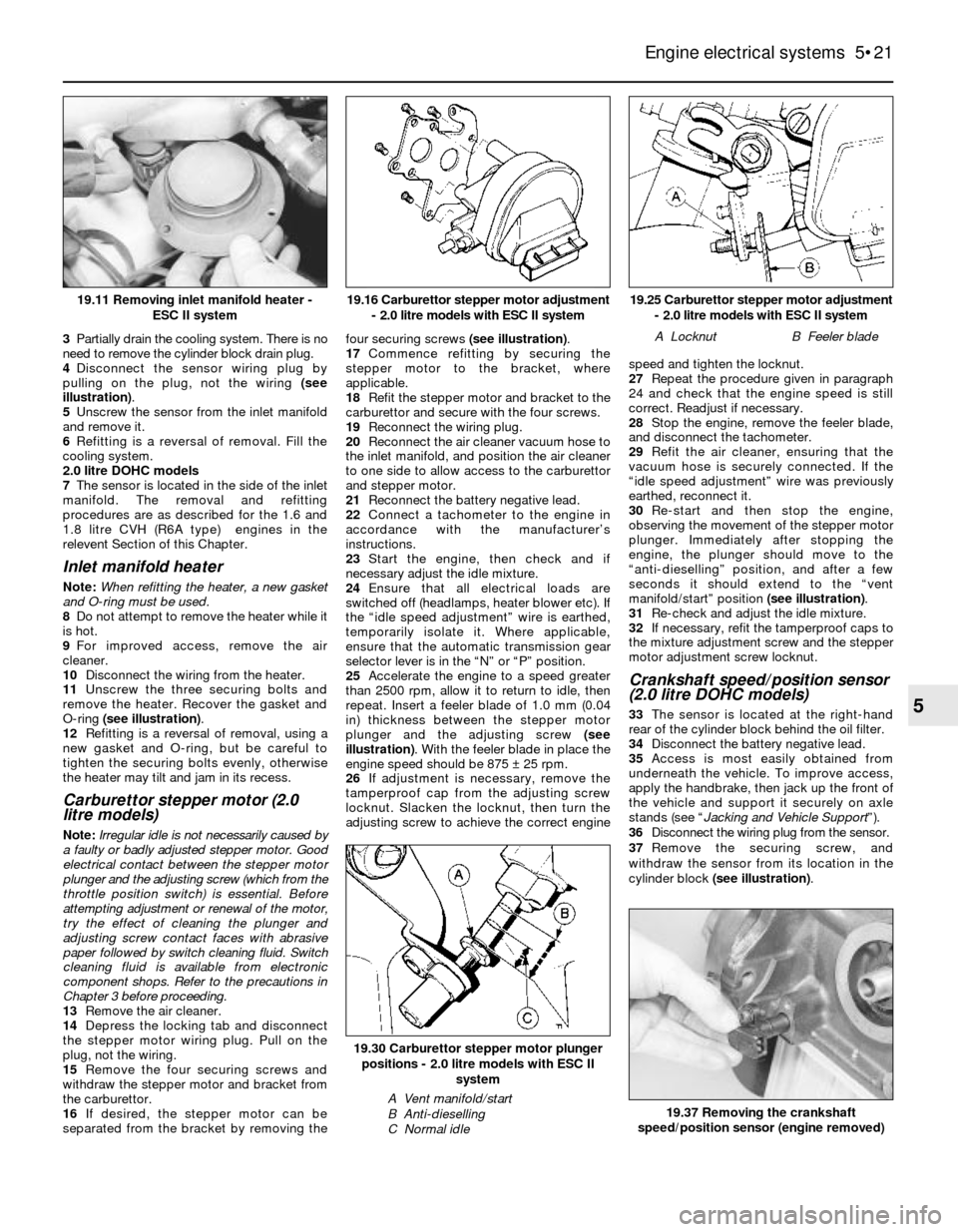
3Partially drain the cooling system. There is no
need to remove the cylinder block drain plug.
4Disconnect the sensor wiring plug by
pulling on the plug, not the wiring (see
illustration).
5Unscrew the sensor from the inlet manifold
and remove it.
6Refitting is a reversal of removal. Fill the
cooling system.
2.0 litre DOHC models
7The sensor is located in the side of the inlet
manifold. The removal and refitting
procedures are as described for the 1.6 and
1.8 litre CVH (R6A type) engines in the
relevent Section of this Chapter.
Inlet manifold heater
Note: When refitting the heater, a new gasket
and O-ring must be used.
8Do not attempt to remove the heater while it
is hot.
9For improved access, remove the air
cleaner.
10Disconnect the wiring from the heater.
11Unscrew the three securing bolts and
remove the heater. Recover the gasket and
O-ring (see illustration).
12Refitting is a reversal of removal, using a
new gasket and O-ring, but be careful to
tighten the securing bolts evenly, otherwise
the heater may tilt and jam in its recess.
Carburettor stepper motor (2.0
litre models)
Note: Irregular idle is not necessarily caused by
a faulty or badly adjusted stepper motor. Good
electrical contact between the stepper motor
plunger and the adjusting screw (which from the
throttle position switch) is essential. Before
attempting adjustment or renewal of the motor,
try the effect of cleaning the plunger and
adjusting screw contact faces with abrasive
paper followed by switch cleaning fluid. Switch
cleaning fluid is available from electronic
component shops. Refer to the precautions in
Chapter 3 before proceeding.
13Remove the air cleaner.
14Depress the locking tab and disconnect
the stepper motor wiring plug. Pull on the
plug, not the wiring.
15Remove the four securing screws and
withdraw the stepper motor and bracket from
the carburettor.
16If desired, the stepper motor can be
separated from the bracket by removing thefour securing screws (see illustration).
17Commence refitting by securing the
stepper motor to the bracket, where
applicable.
18Refit the stepper motor and bracket to the
carburettor and secure with the four screws.
19Reconnect the wiring plug.
20Reconnect the air cleaner vacuum hose to
the inlet manifold, and position the air cleaner
to one side to allow access to the carburettor
and stepper motor.
21Reconnect the battery negative lead.
22Connect a tachometer to the engine in
accordance with the manufacturer’s
instructions.
23Start the engine, then check and if
necessary adjust the idle mixture.
24Ensure that all electrical loads are
switched off (headlamps, heater blower etc). If
the “idle speed adjustment” wire is earthed,
temporarily isolate it. Where applicable,
ensure that the automatic transmission gear
selector lever is in the “N” or “P” position.
25Accelerate the engine to a speed greater
than 2500 rpm, allow it to return to idle, then
repeat. Insert a feeler blade of 1.0 mm (0.04
in) thickness between the stepper motor
plunger and the adjusting screw (see
illustration). With the feeler blade in place the
engine speed should be 875 ±25 rpm.
26If adjustment is necessary, remove the
tamperproof cap from the adjusting screw
locknut. Slacken the locknut, then turn the
adjusting screw to achieve the correct enginespeed and tighten the locknut.
27Repeat the procedure given in paragraph
24 and check that the engine speed is still
correct. Readjust if necessary.
28Stop the engine, remove the feeler blade,
and disconnect the tachometer.
29Refit the air cleaner, ensuring that the
vacuum hose is securely connected. If the
“idle speed adjustment” wire was previously
earthed, reconnect it.
30Re-start and then stop the engine,
observing the movement of the stepper motor
plunger. Immediately after stopping the
engine, the plunger should move to the
“anti-dieselling” position, and after a few
seconds it should extend to the “vent
manifold/start” position (see illustration).
31Re-check and adjust the idle mixture.
32If necessary, refit the tamperproof caps to
the mixture adjustment screw and the stepper
motor adjustment screw locknut.
Crankshaft speed/position sensor
(2.0 litre DOHC models)
33The sensor is located at the right-hand
rear of the cylinder block behind the oil filter.
34Disconnect the battery negative lead.
35Access is most easily obtained from
underneath the vehicle. To improve access,
apply the handbrake, then jack up the front of
the vehicle and support it securely on axle
stands (see “Jacking and Vehicle Support”).
36Disconnect the wiring plug from the sensor.
37Remove the securing screw, and
withdraw the sensor from its location in the
cylinder block (see illustration).
Engine electrical systems 5•21
5
19.25 Carburettor stepper motor adjustment
- 2.0 litre models with ESC II system
A LocknutB Feeler blade
19.37 Removing the crankshaft
speed/position sensor (engine removed)
19.30 Carburettor stepper motor plunger
positions - 2.0 litre models with ESC II
system
A Vent manifold/start
B Anti-dieselling
C Normal idle
19.16 Carburettor stepper motor adjustment
- 2.0 litre models with ESC II system19.11 Removing inlet manifold heater -
ESC II system